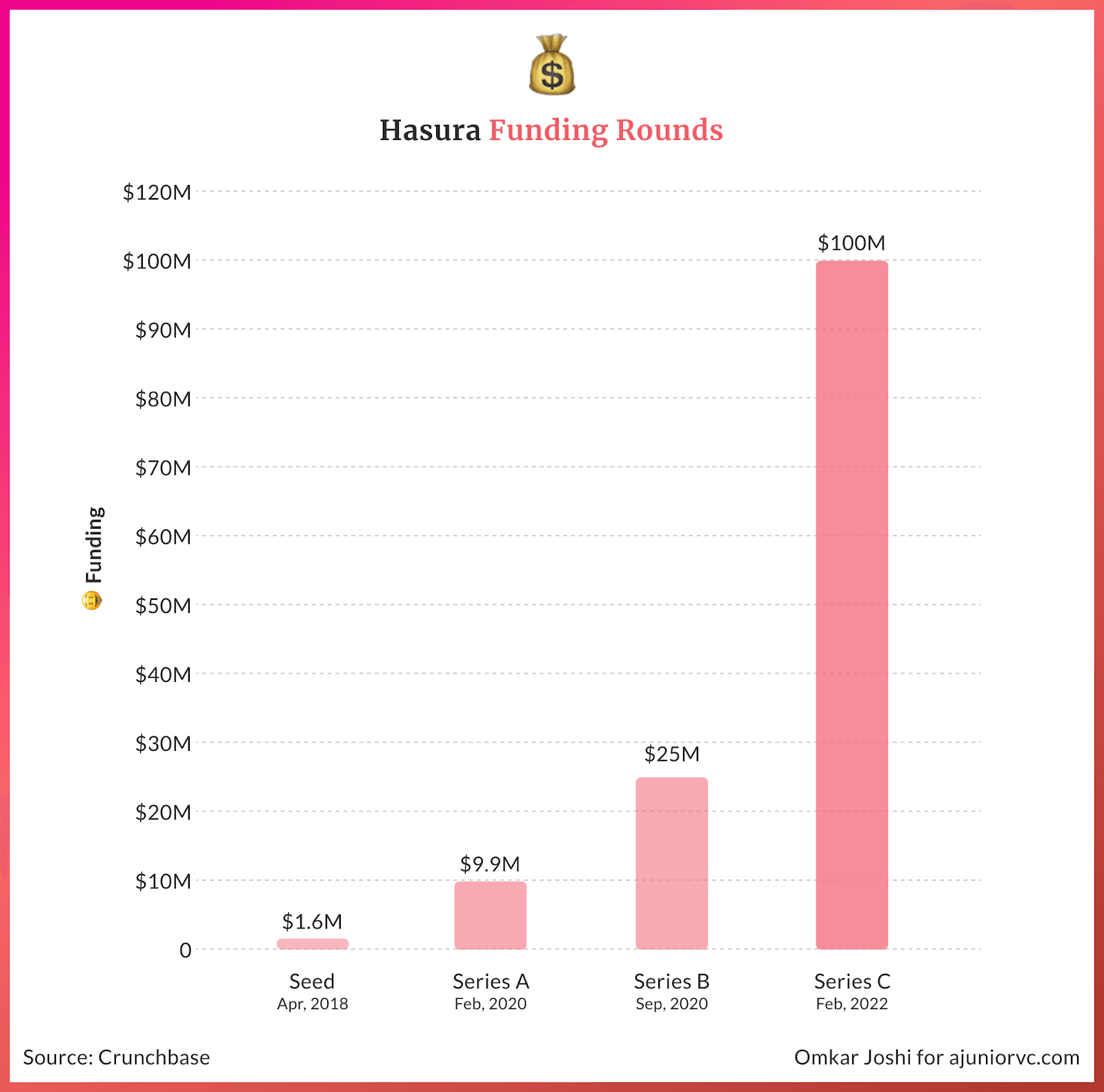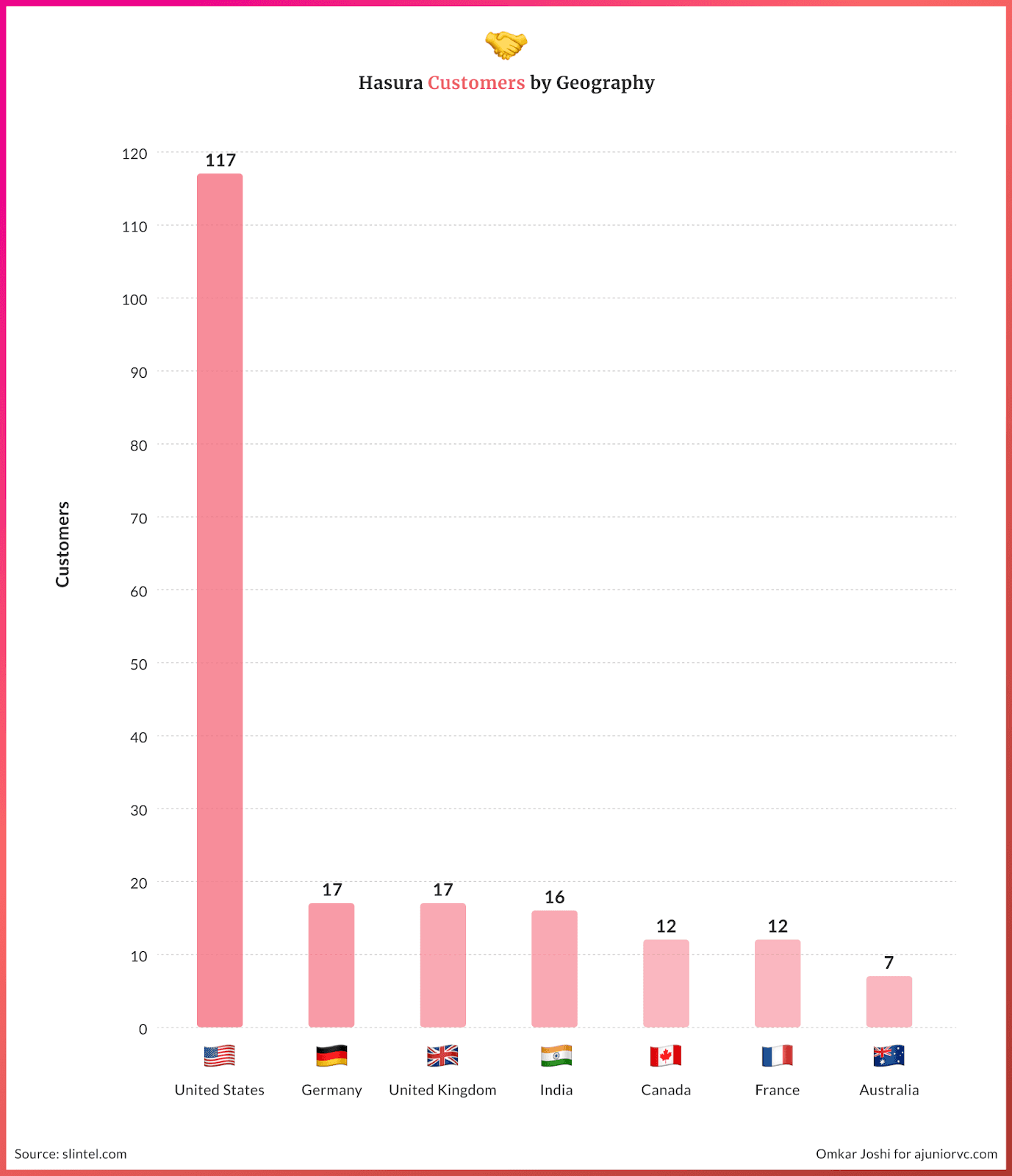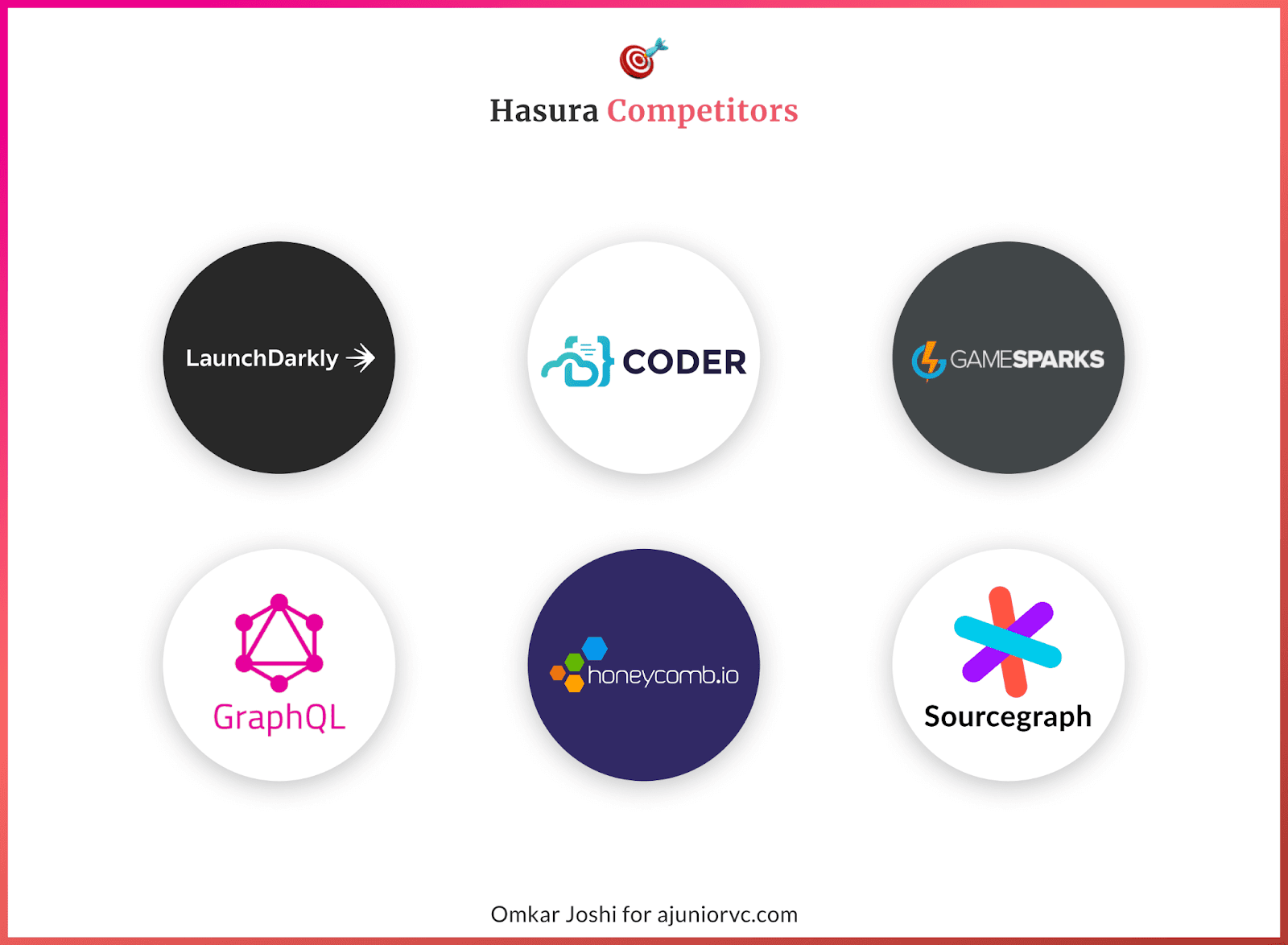
May 1, 2022
Can Hasura's APIs Link the World's Data?
Profile
DevOps
Productivity
SaaS
Platform
Series B-D
B2B
Last fortnight, Indian upstart Hasura enabled GraphQL hot on the heels of becoming India’s newest DevOps unicorn
Joining Tables
Rajoshi Ghosh was looking to try out some good local food in Chennai in 2016.
Unable to explore the streets of the city for local delicacies due to her busy schedule, she relied on the food delivery apps. However, to her disappointment, she could only find the famous dishes/fast food on those apps.
Craving home-cooked food, she set out to start a food delivery company called Find a Kadai that would cater to only home-cooked food.
In the process of building her company, Rajoshi met Tanmai Gopal, who had just completed his post-graduation in Computer Science.
A technologist by trade, Tanmai was looking to explore business ideas and co-found a startup. Serendipitously, Rajoshi and Tanmai connected and their mutual appreciation for food led them to work on the food delivery app.
Unlike the straightforward stories you hear in academic textbooks, Rajoshi and Tanmai realised that the actual app development was a behemoth task. The frameworks for various stages of app development were not talking to each other.
In 2016, when building applications was a novelty, having these talk to each other wouldn’t be a large enough problem.
Struggling, the two decided to look wide for a solution.
Large Commit
The big problem faced by the duo was the lack of coordination in the application development ecosystem
The front end wouldn’t talk to the back end, deployment wouldn’t talk either. There was no common framework.
Developing apps was an orchestration problem as much as a building problem. The fact it operated that way made developers frustrated and unproductive.
To solve this, they aimed to find a tech stack composed of pieces that could communicate with each other without wasting developers’ time.
The need to streamline the process became their topmost priority. When their search for such a platform failed, they did what all founders do.
The founders built it.
The duo created an internal platform called procrust.es to enable developers to code without worrying about changes in databases.
Awareness building, literally
Procrust.es was a database platform which enabled users to combine NoSQL APIs with the ability to handle transactions. This helped them to build new applications quickly.
The smell of what was cooking in Tanmai’s kitchen spread among other developers who were looking to simplify the app development process for their apps. They all wanted a procrust. es type platform for their own companies.
One thing led to another and the co-founders decided to make Procrust’s technology as the main selling point of the company.
The pair moved from creating a food delivery app to building an open-source GraphQL engine.
After several iterations, Hasura was born in 2017, to build APIs-as-a-service.
Beta Testing
As Hasura was starting out, software development was in another cycle of redevelopment.
Development has seen a revamped production & environment cycle every few years. While these new wheels turn for faster speed to execution, they are always associated with their own unique set of challenges.
2017 saw the onset of three development blocks that redefined how software is built, run and operated.
All 3 were created to move away from “monolithic” architecture. Monolithic architecture tended to be hard to scale because it was one large block.
The new architectures would be built on unbundling software development. Rather than one large block, you would have multiple Lego blocks.
These could be assembled to build the product, rather than building the whole product from scratch. The new era was structured into three large concepts.
The first was microservices, which was a set of loosely coupled functional services. Microservices would solve one function only, say search or shipping, being combined to build the experience.
The second was containers. This was an environment to run the microservices packaged with necessary run-time elements. Containers were built solely to see if the microservices functioned standalone. It would be useful to see how they operated solo.
The final piece was container orchestration. This would involve making the containers operate in unison. This piece of the framework would help running multiple microservices packed within multiple containers
As software ate the world, engineering was becoming mission-critical. Solving for the bandwidth and ease of use of developers was new. A new world of “developer tools” or “dev-ops” was slowly coming to life.
It was in this new world that Hasura decided to build.
Building Bits
Hasura wanted to make it easy to work with modern developer tool infrastructure.
By 2018, the company’s early product build had led them to raise a first seed round of $1.6M.

It would operate with tools like Kubernetes and Docker, that were building out this new generation of development.
The team was early to realise this need and developed simplified tools thereby helping developers cut the back-end development cycle.
But this was early and ahead of the time.
There was another unsolved problem very early in the lifecycle of software development, that needed a modern revamp before reaching container orchestration - the core, access to data.
Unless there was seamless access to data, transforming the data into something meaningful and feeding the right data models and insights through modern infrastructure was of less value.
To solve this, Hasura began to develop an open-source tool. It would create GraphQL APIs that works to translate user queries in a standardized format before firing at the backend databases.
This would be a classic first principles insight, that would set the stage for the creation of multiple such open-source community-led scales.
It saved developers from creating a differentiated mapping for diverse interfaces & constantly maintaining standards across the systems. The creation of APIs on a click of button to make sense of data was powerful.
The intention was clear.
Hasura would become a platform enabler, giving immense power to the users themselves and evolving on the fly by touching a diverse spectrum of use cases and developers.
Debugged Growth
Hasura’s GraphQL Engine, the core of all Hasura products, became open source in early 2019.
Its downloads grew exponentially: 2 million in 2019, 100 million in 2020, 250 million in 2021 and trending at 500+ million this year.
With Hasura identifying developers as their customers in this new world, the love they would get would be immense. Hasura would explode to 26,000 stars on Github - which had become a platform and community for developers.

This was special, for multiple reasons.
Hasura was probably the only team apart from Postman that was seeing this kind of love. In a world where Indian software is treated as “imitation”, Hasura was pioneering a gold standard.
They were solving for developers directly.
In addition to building from India for the world of developers, Hasura had nailed a new kind of customer acquisition motion. “Bottom-up”, and “product-led” were more buzzwords than reality in 2019, but Hasura had made it a reality.
By building for developers, it was seeing an exponential kicker in adoption.
Developers would come to GitHub looking for a solution to work better with their APIs. They would find buzz around the GraphQL engine. Developers who loved it would give stars.
Open-source would result in more people building on it, which would result in improvements.
The flywheel of real networks was being seen in what may have been termed as a “business” tool.
The developer's love would soon begin to translate into customer love.
Processing Customers
By 2020, the company was starting to evolve into a business.
Hasura was one of the few companies in the world that found a way to serve both Fortune 100 companies as well as fast-growing startups.
The company would start acquiring large conglomerates like Walmart and Philips Healthcare as well as startups like Swiggy. Unlike software companies that sold “top-down”, Hasura’s “bottom-up” developer-led acquisition opened doors in a variety of company sizes.

The company’s vision was to serve as a universal proxy layer. Hasura would sit in between databases in the backend and consumers in the frontend such as mobile/web apps.
This was lapped up by companies at every stage of the life cycle. Think Google Translate but much more complex and for databases and software.
This capability enabled enterprises to slowly move to GraphQL from the world of REST APIs. This would happen seamlessly while solving for the missing capabilities like out-of-box authentication that were hindrances for them to do so.
Their forward-looking product strategy equipped the next generation of developers to seamlessly build web applications that could scale.
Seeing their growth, the company raised two rounds of funding in quick succession. 2020 would fuel Hasura with $35M to take off.
It was well deserved.
Hasura solved the missing piece of data infrastructure that nobody realized they needed. It now needed to convert customer love into dollars.
For an “open-source” tool, that was not straightforward
Batching Money
How Hasura would make money in 2021 was unclear.
By the virtue of its ‘open-source’ ideology, Hasura was free for individual users to download and consume.
It truly adhered to the very concept of open-source which is aligned with community and network distribution principles.
Hasura had reached a growth flywheel. Developers worldwide had started using the product and were contributing to the product development as goodwill in exchange for free usage.
This kept strengthening the product by driving a continuous feedback loop across ~500 developers.
In early 2021, Hasura also began to explore a new pricing model.
Hasura offered a ‘pay-as-you-go’ model for the teams using the premium features. It began to explore implementing a consumption-based pricing model against a standard license fee-based model.
Under this Standard Pro model, consumption pricing would mean high predictability for customers and demonstrate value on the go.
There might be industry concerns about how Hasura is planning to monetize a product which was open source and had immense value to the developer ecosystem.
While Hasura planned to continue sticking to the open-source ideology, there was a slow but concrete path to creating a commercial ship.
Moreover, globally, there have been incredible value outcomes in the world of open-source enterprise software. Successes of Gitlab, Github, Hashicorp & Confluent have proven that open source companies can become big and sticky.
Hashicorp, for instance, was valued at 25-30x of its NTM assuming a 50-70% annual growth rate. Gitlab and Confluent were in a similar valuation bracket.
Hasura’s valuation growth would therefore have reasonable grounding.
The companies have proven, that once the open-source product establishes value and becomes sticky, there are multiple ways to monetize the development.
Creating consumption-based pricing for corporate teams, charging for advanced features while keeping a basic version free or charging for support of assistance along with the core offering were key monetization strategies.
At the core, though, remained community.
Community, Community, Community
By 2022, Hasura was scaling having figured out a monetization and growth flywheel.
Hasura continued to expand its TAM by progressively expanding its suite of offerings. For example, once their GraphQL hit escape velocity, they launched support for MySQL.
MySQL was one of the prominent relational database systems and was still most aggressively used in the health care and financial sectors.
This opened up a new vertical of potential users that were waiting to flock to a cool, valuable product for efficiently running complex pipes between the front end and back end.
The niche space Hasura has carved out for itself is potentially an untapped one, with other players yet to catch up to the market.
It is not a replacement for Prisma 2 or Apollo, which are the most popular database management tools today, but rather works orthogonally with them.
Hasura brings simplicity to its user's fingertips with Backend-as-a-service or BaaS
Their APIs convert the data requests from the frontend to a database at the backend. This significantly brought down the development and maintenance time for developers and increases productivity exponentially.

Hasura also evolved its business model to an open core model. The monetisation strategy employed offers a premium version for the paying customers and limited features for the community.
It wouldn’t be the first SaaS company to employ such a model. Elastic does the same, with ElasticSearch Kibana offered under an Apache 2.0 license.
Along with this, Hasura run a MooC on application development with IIT-Madras aiming to empower students and professionals to build modern applications.
It is India’s largest MOOC and an initiative to raise awareness about the open-source community in India.
Hasura has used its community as a competitive moat over the years and will continue to do so in the future.
It still has a long way to go.
C the Future
For open source businesses, around 3-10% of the community converts to commercial paying customers.
India’s open-source community is seeing exponential growth.
India is GitHub’s third-largest market and has seen the number of public repositories in India grow by 75% in 2022. Encouraged by this, GitHub opened its local development centre in India before China.
The Government of India is doing its bit to encourage open source development by launching policies supporting its growth and adoption as part of the Digital India initiative.
Hasura is ideally placed in this situation through the vibrant developer community it has built around its core products.
It works as a self-serve mechanism where consumers are encouraged to try out products on their own, see economic value in them and then convert to enterprise or paid users.
Hasura has immense potential in the future to grow its customer base by tapping into its ever-evolving community.
This is especially true given that the Indian developer ecosystem comprises nearly a quarter of the world’s engineers.
But the go-to-market strategy still needs to be evolved further and this is possibly going to be their core focus in the coming years.
The difficulty with being open-source and trying to build a business is the opposing forces. Going hard on one side could alienate the other.
The tightrope will need to crossed to help Hasura get to scale.
The evolution of Hasura’s GTM strategy will be heavily influenced by the requirements of the product rather than the business needs, which has historically not been the case in the Indian ecosystem.
The future is tough, but the foundations set by the Hasura team look promising.
Writers: Shiraz Kazmi, Shelley Singh, Manshi Sanghai, Saniya Chawla and Aviral Bhatnagar Design: Omkar Joshi and Blair Leblanc